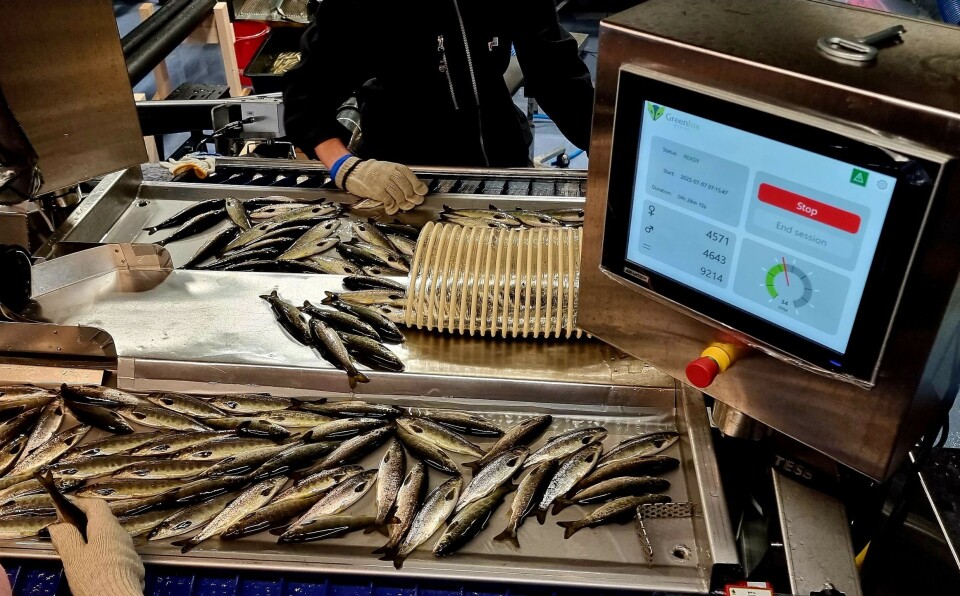
Patent awarded for smolt sexing machine
Fish in single-gender pens have faster growth, lower mortality, and fewer wounds, says the technology's developer
A company that has developed a machine for automatic sex sorting of salmon smolts has had its patent application approved in Norway.
GreenFox Marine says its solution should provide the fish with better conditions for increased welfare and growth.
“Automatic sex sorting of salmon smolt helps to solve one of the industry’s biggest challenges with high mortality in the marine phase, as well as contributing to increased productivity,” said general manager Erling Aspen.
“The fact that the core function of our technology is now patented also gives us extra security in the further work, which is aimed at further industrialisation and commercialisation of the solution.”
Many advantages
According to Aspen, the advantages of sex sorting are many, both for the fish and for the farmers.
“Fish in sex-separated cages grow faster, have lower mortality and fewer wounds. At the same time, farms can optimise production for each sex through differentiated harvest times, light management, localisation, and other such measures.
“You will also be able to reduce the time the fish spend in the sea, which in turn will have positive effects with fewer lice on the fish. A more uniform size of the fish will also simplify production, at the hatchery, in the cage and at the slaughterhouse,” explained Aspen.

GreenFox’s now patented machine is an automated solution for sexing fish using ultrasound and artificial intelligence (AI).
3,500 fish per hour
The company currently has stand-alone machines that sort up to 3,500 fish per hour. At the same time, new machine solutions are being worked on, where the speed can approach 40,000 fish per hour. The machine operates with an accuracy of 97% to 99%, the company says.
The alternative to automatic sorting today is manual sorting with hand-held ultrasound, which according to GreenFox is considerably more time-consuming and has a lower accuracy.
This is how the machine works:
1. The anesthetised fish is fed into the machine, where it is automatically guided over an ultrasound probe.
2. The machine uses 16 high-resolution ultrasound images of the fish, which are sent on to GreenFox’s AI model.
3. The AI model takes 0.03 seconds to analyse the images and determine whether the fish is male or female.
4. The fish is sorted into the correct vessel.
The solution is currently used for both broodstock and juvenile fish.

Norway, Scotland, and Faroes
Several of the largest farming companies in Norway have already adopted the solution. Since June this year, GreenFox has sorted almost 2 million salmon smolts, for, among others, AquaGen, Mowi, SalMar, Benchmark Genetics and Måsøval.
The company has also sold machines in both Scotland and the Faroe Islands and has received inquiries from a number of other countries. There has been particularly great interest from the Chilean market, which currently sexes more than 50% of all farmed salmon manually, which means more than 100 million fish a year.
The solution can also be integrated into vaccination machines, so that the fish are sexed at the same time as they are vaccinated.
Aspen says that they are working on several projects to add additional functions to the machine.
Health index
“At the same time as the fish are sexed, we want to give the fish a health index, which says something about the fish’s robustness and ability to survive a life in the sea. We will do this by examining abnormalities in the heart, liver, and kidneys with ultrasound,” he said.
“We are already enrolled in a project dealing with the heart, and have started work on being able to detect nephrocalcinosis (kidney disease) at an early stage. Nephrocalcinosis is one of the biggest causes of fish death in hatchery fish and in the marine phase.”
In the long term, GreenFox will also adapt the machine to more fish species.
A survey carried out on behalf of GreenFox revealed a total of 16 species worldwide that are suitable for farming and would greatly benefit from sexing using ultrasound.
“The industry has already requested gender sorting of a number of fish species, such as trout, sturgeon and perch. In the first instance, we are in the initial phase of a project with Norcod, for gender sorting of cod,” concluded Aspen.























































